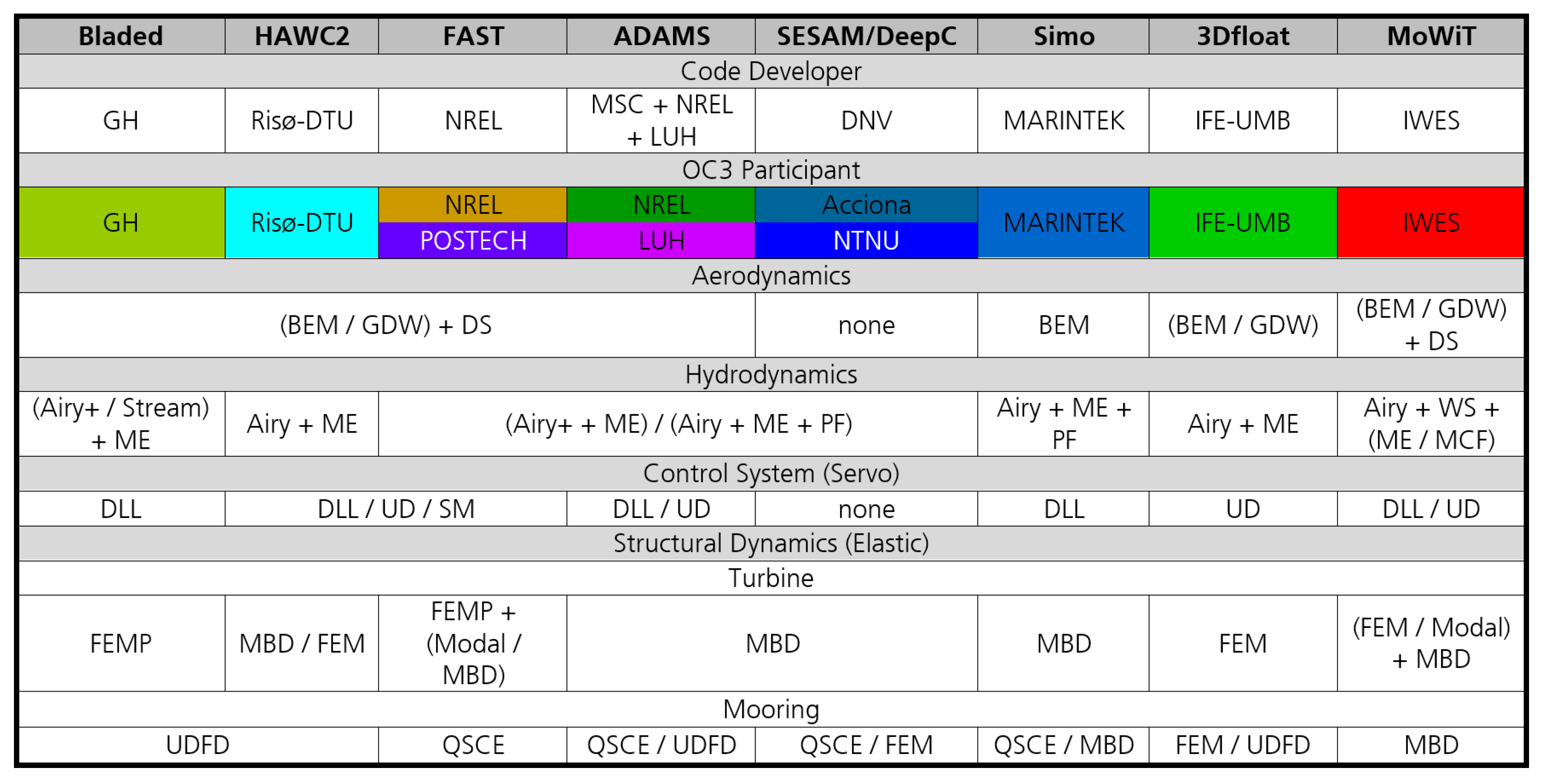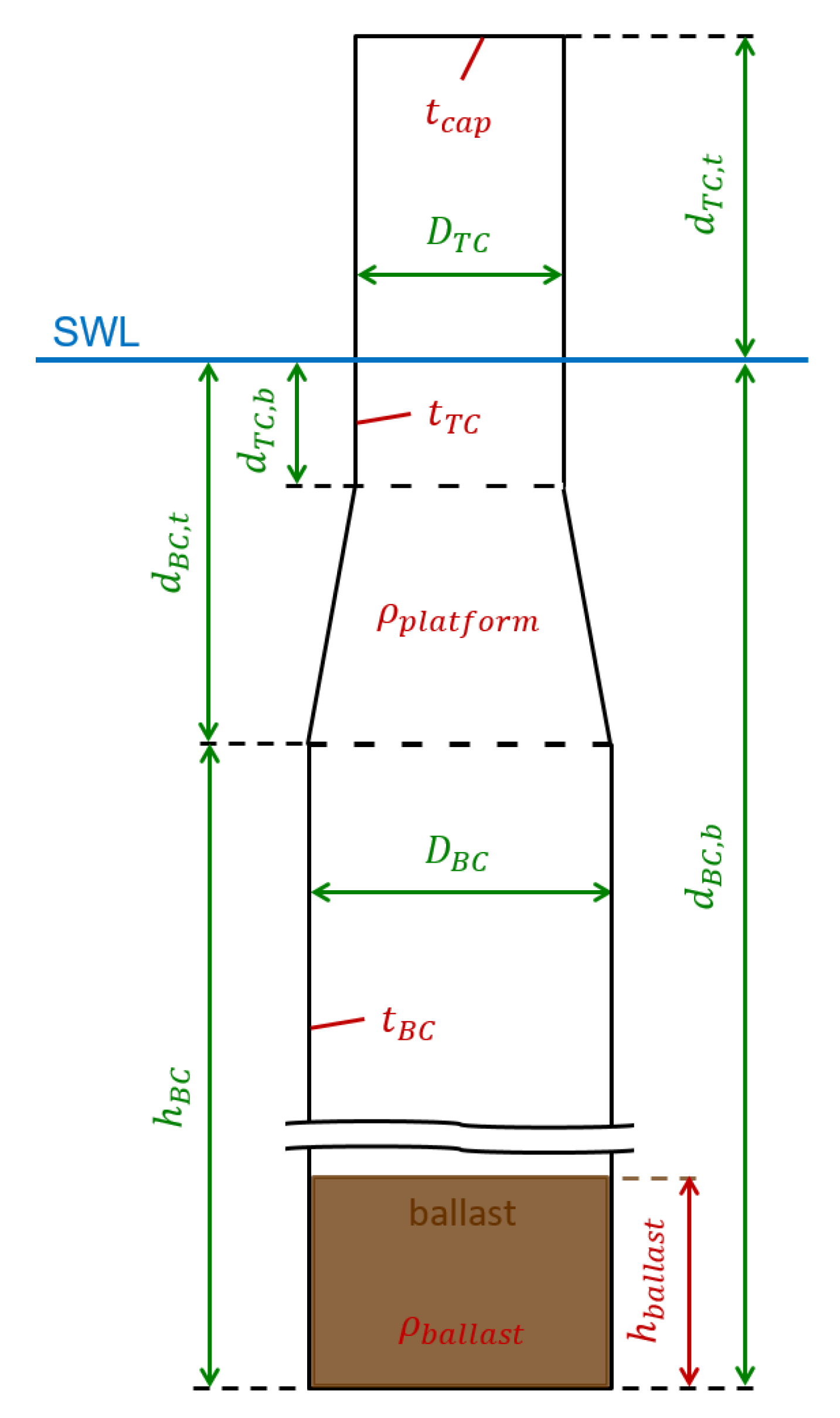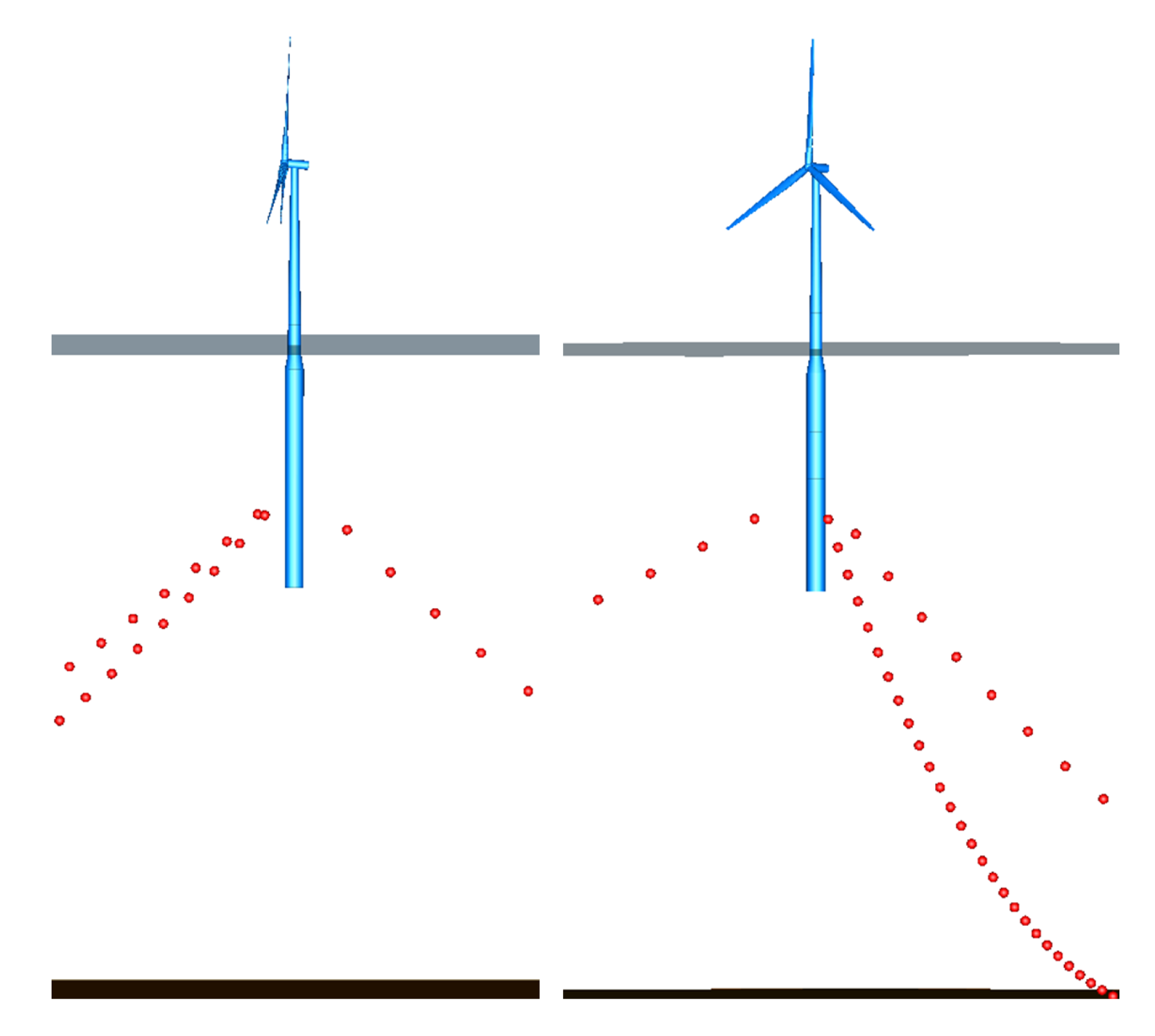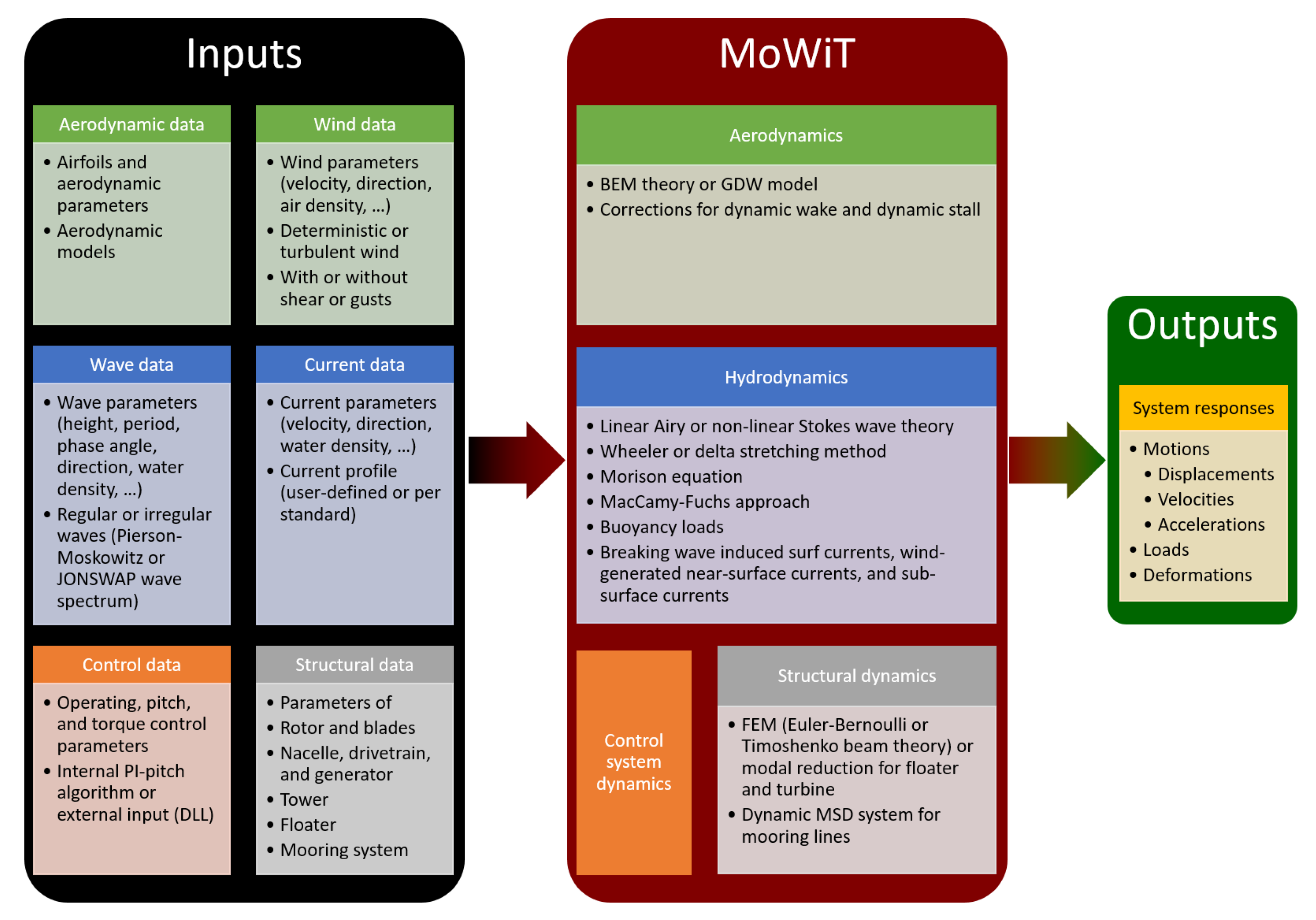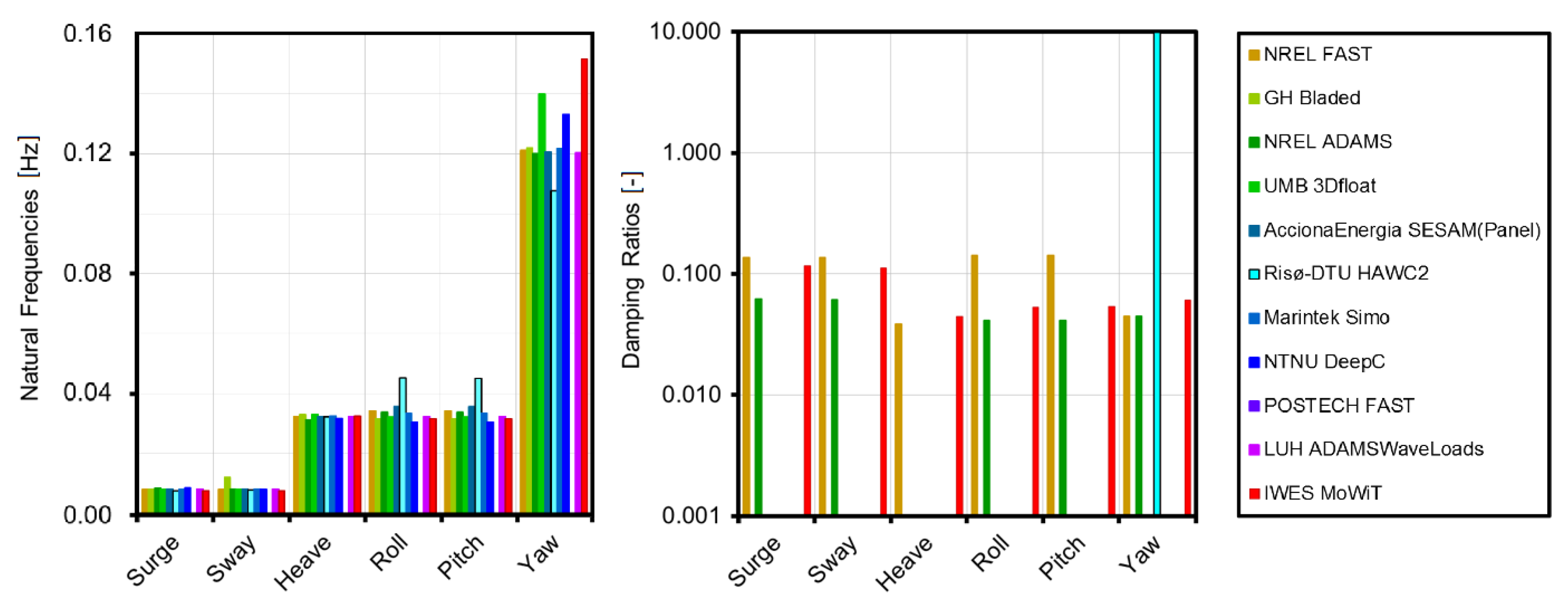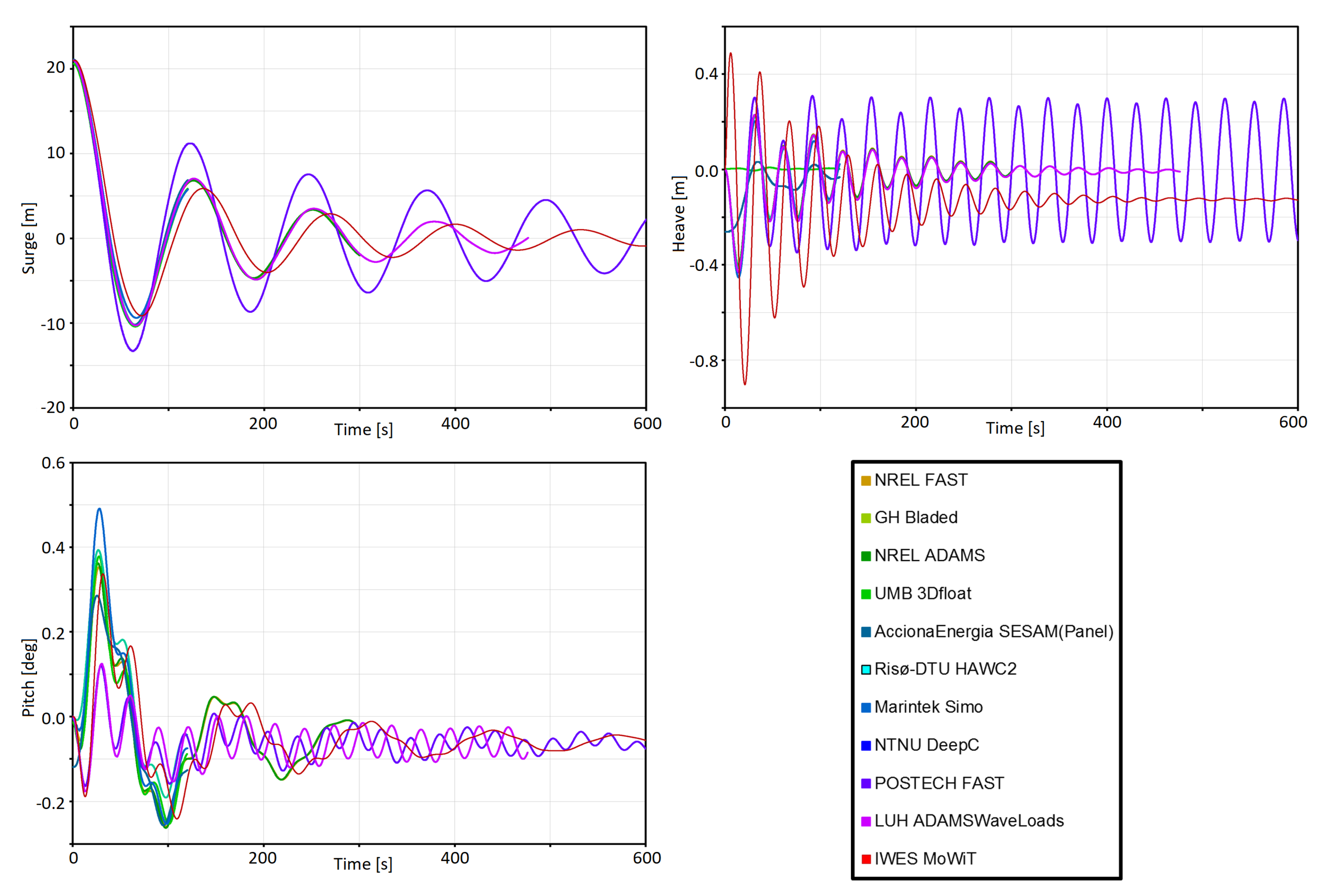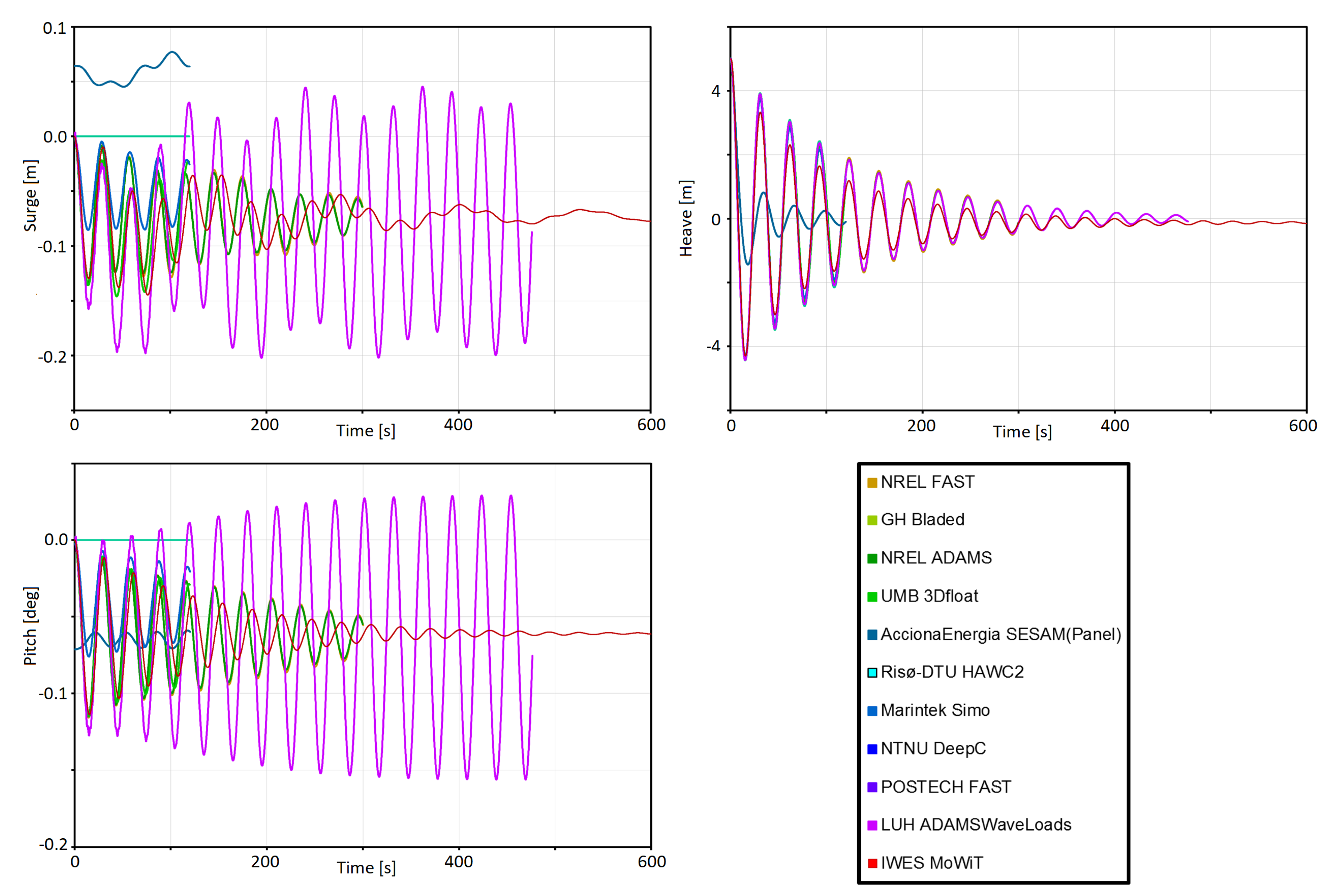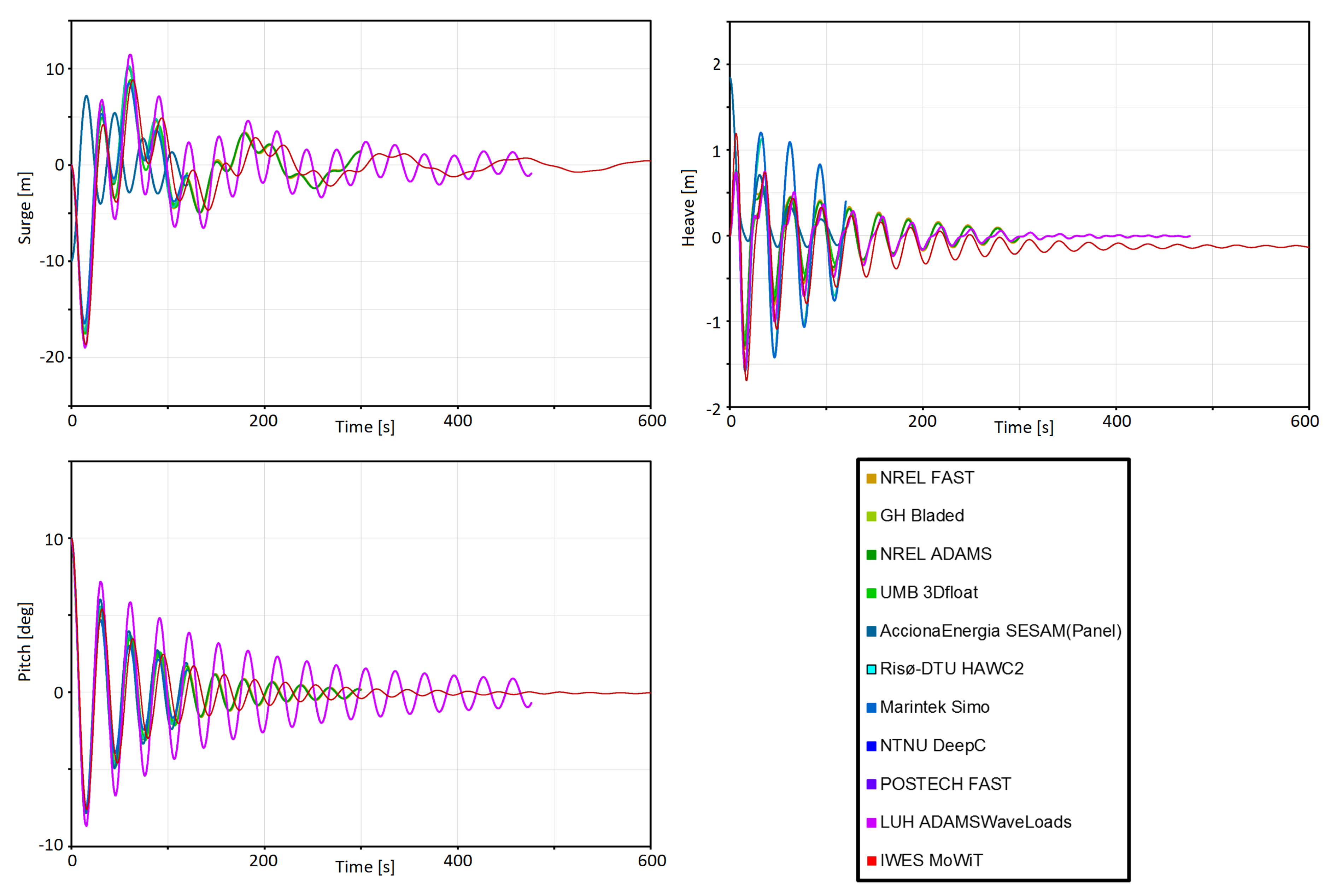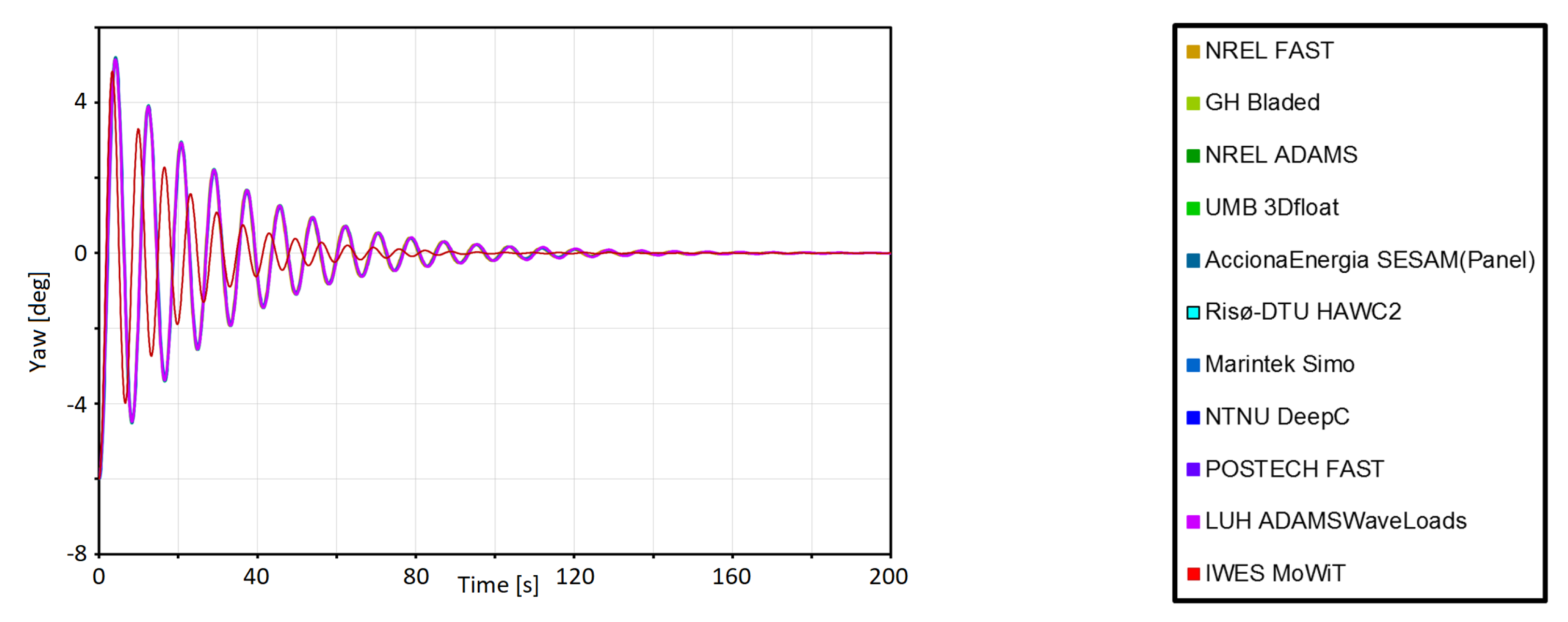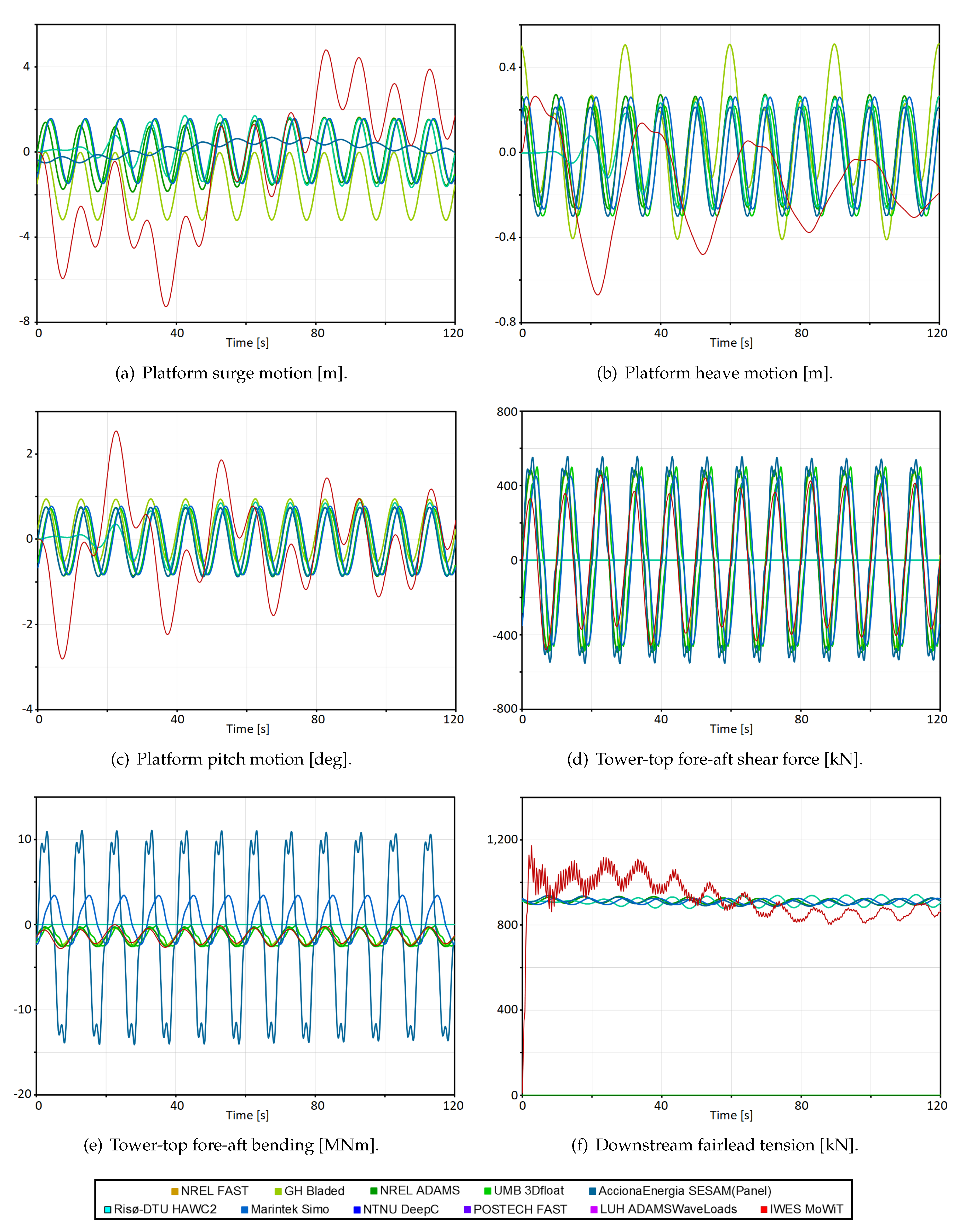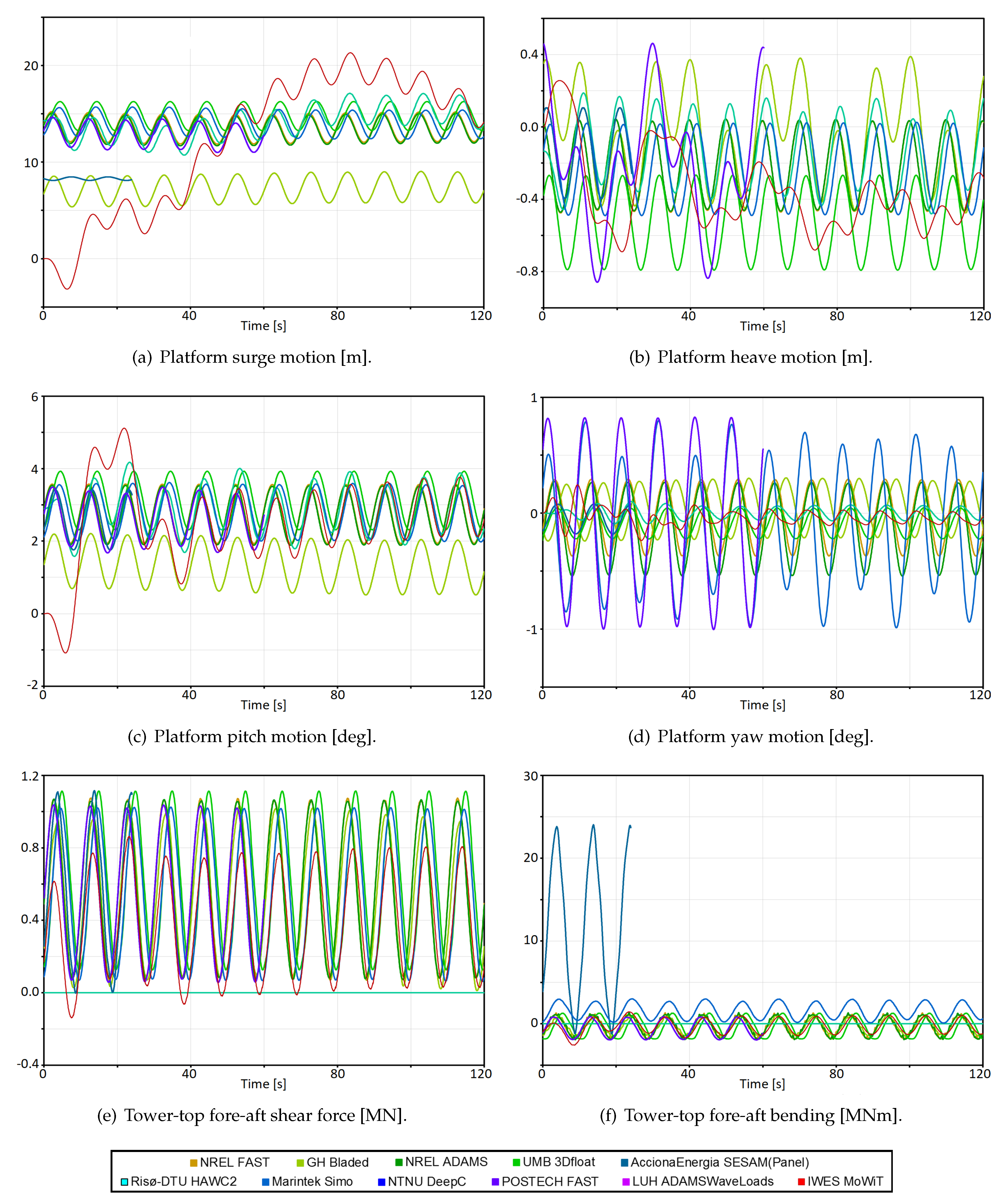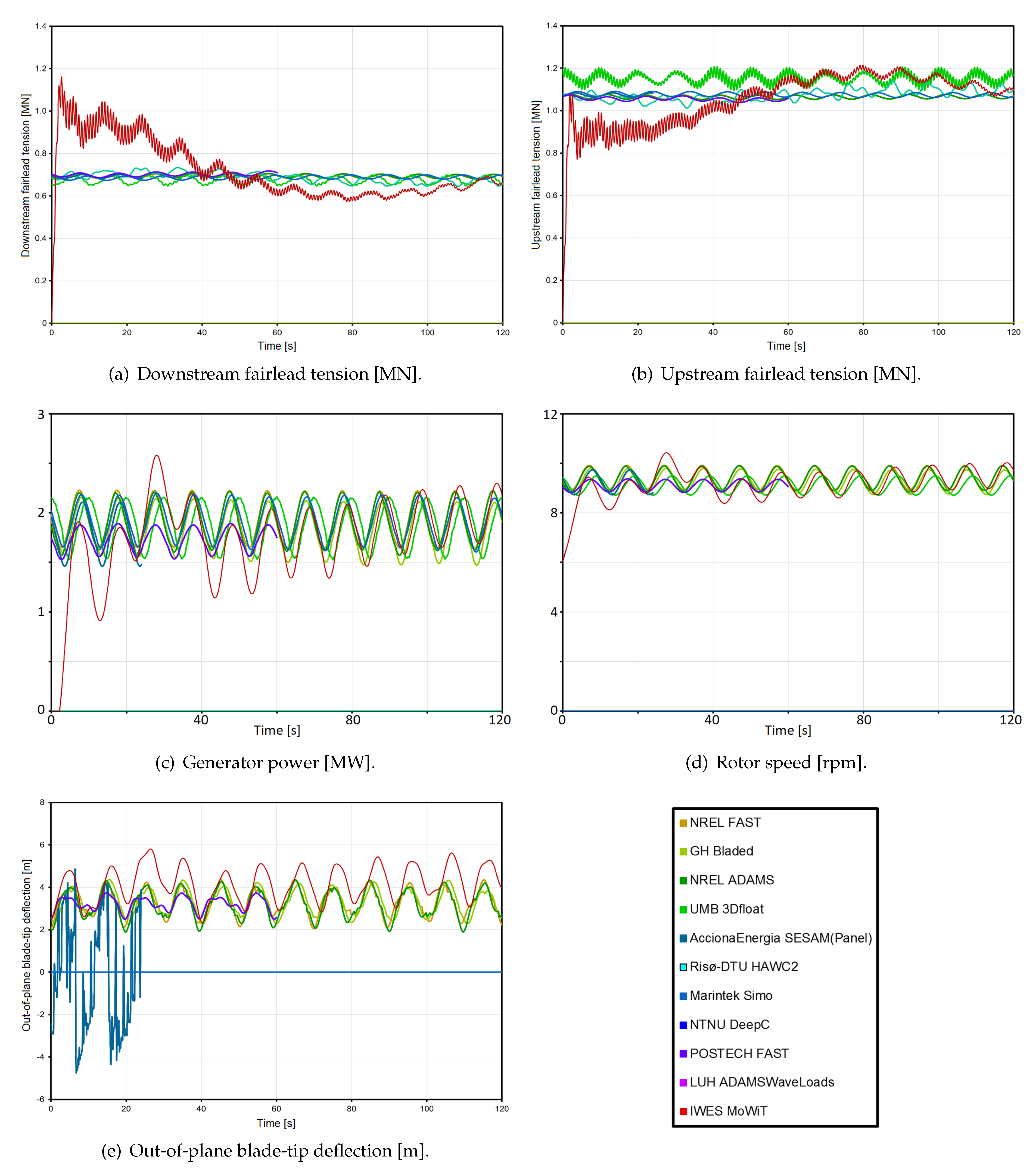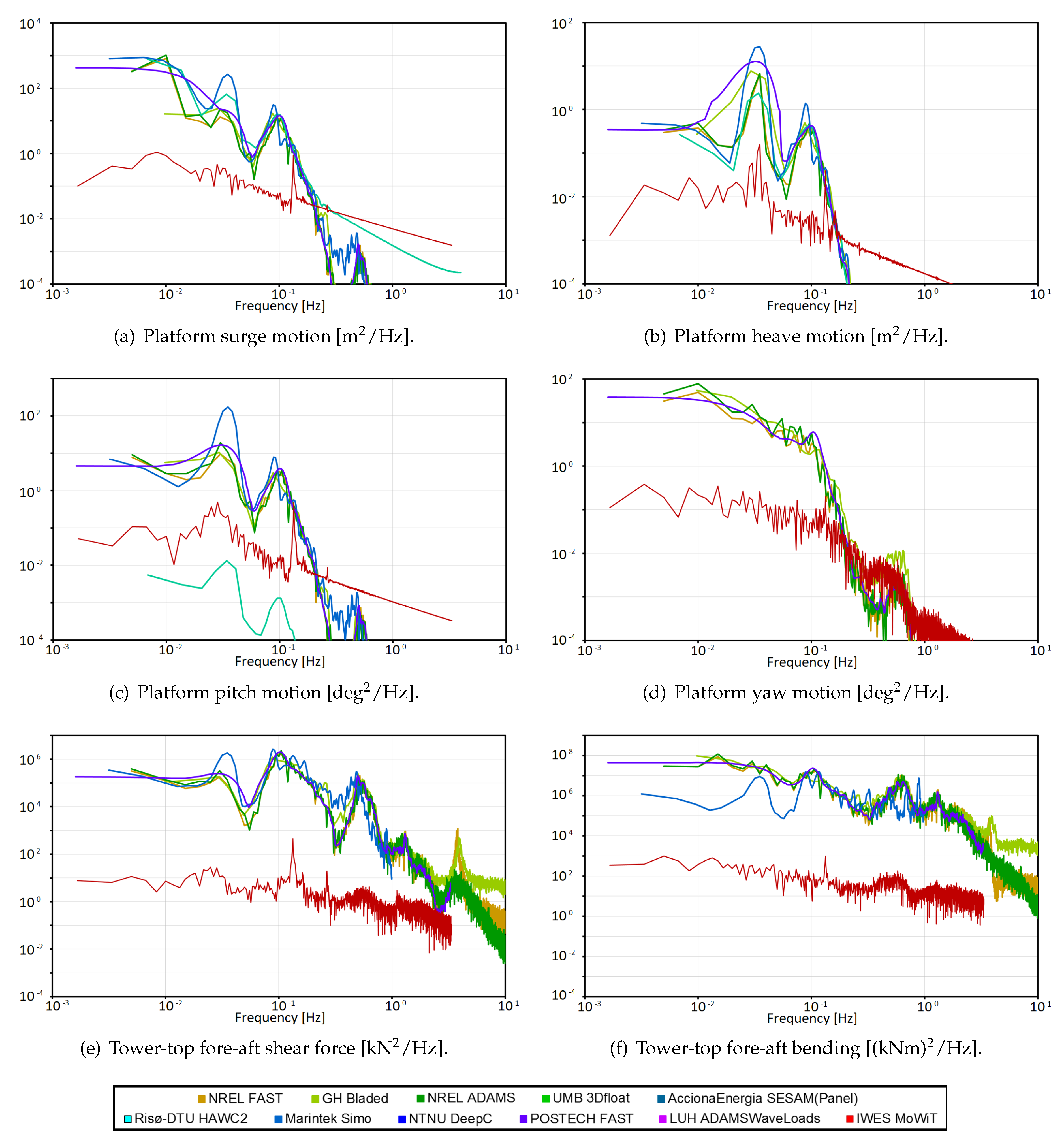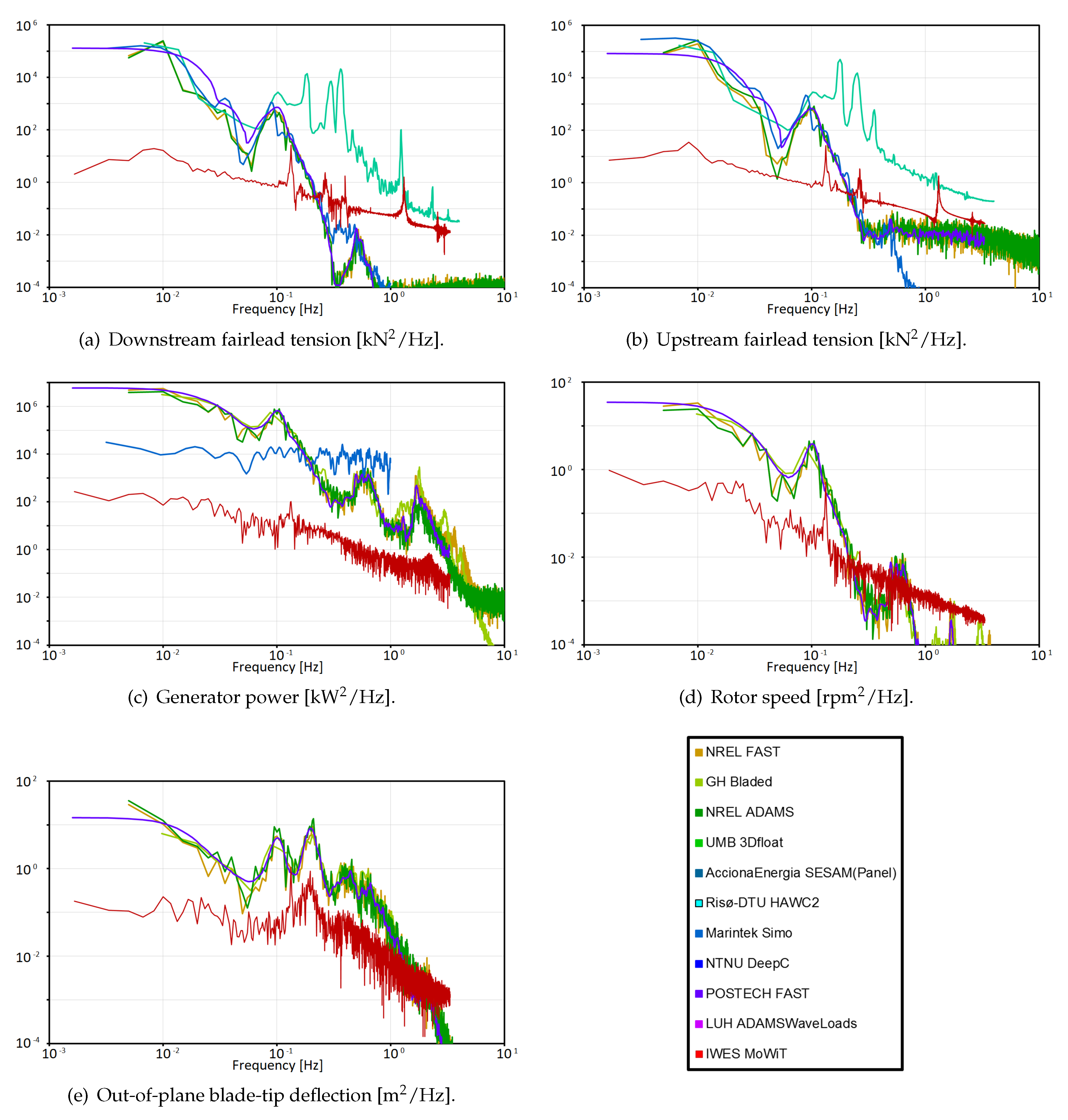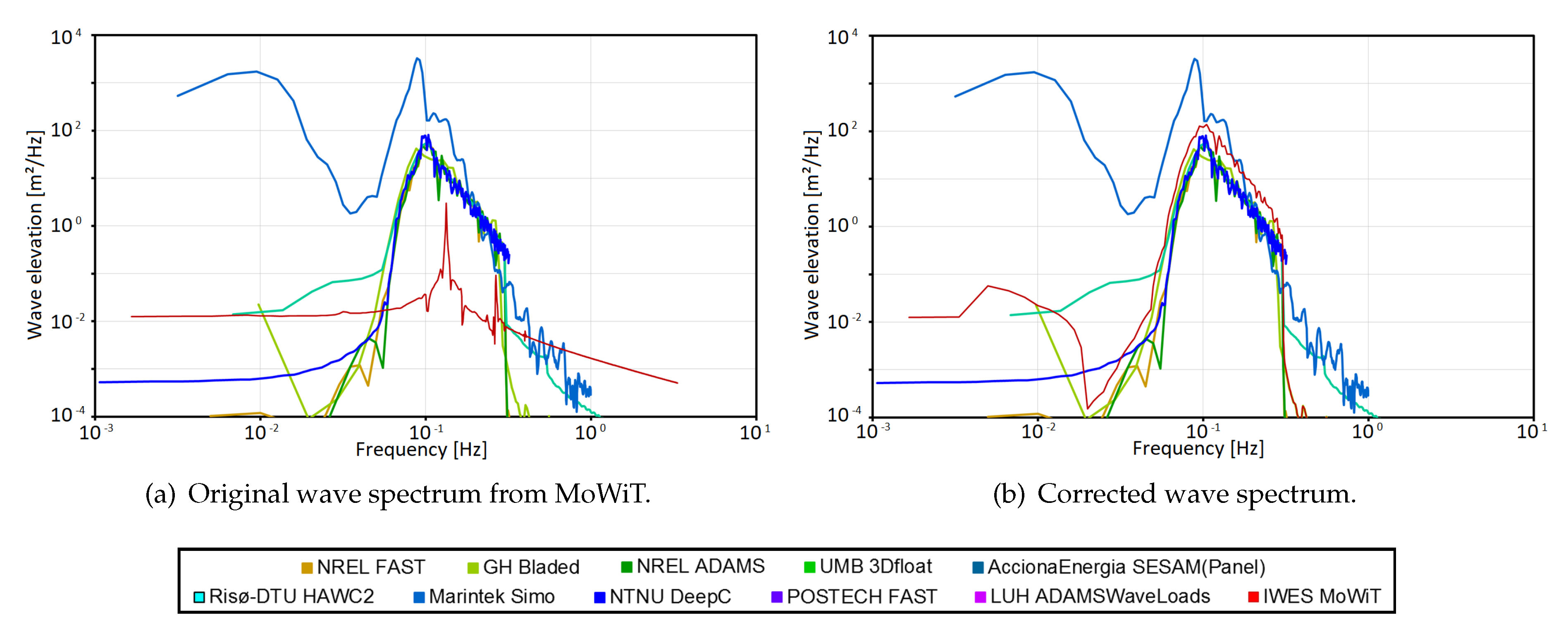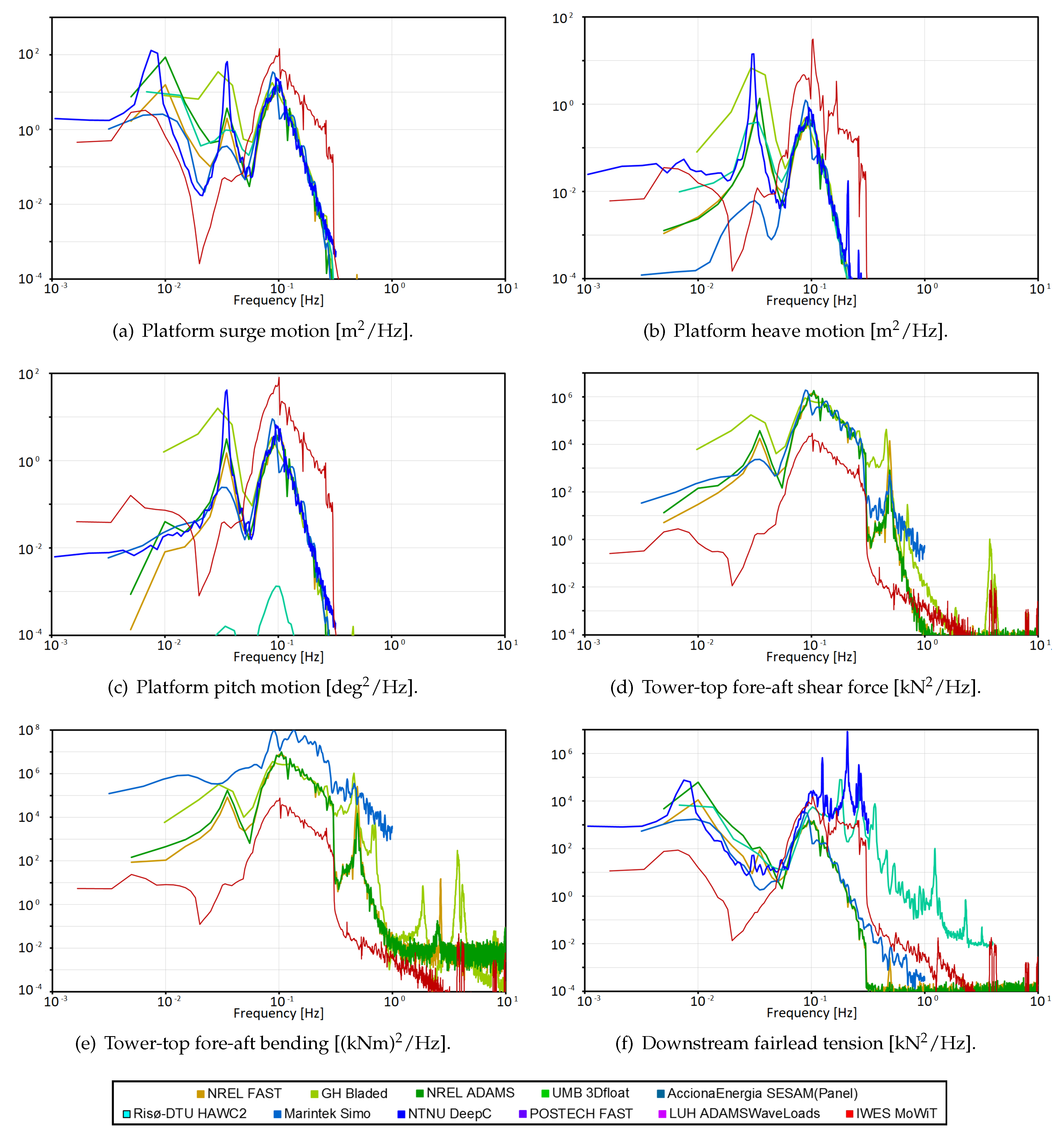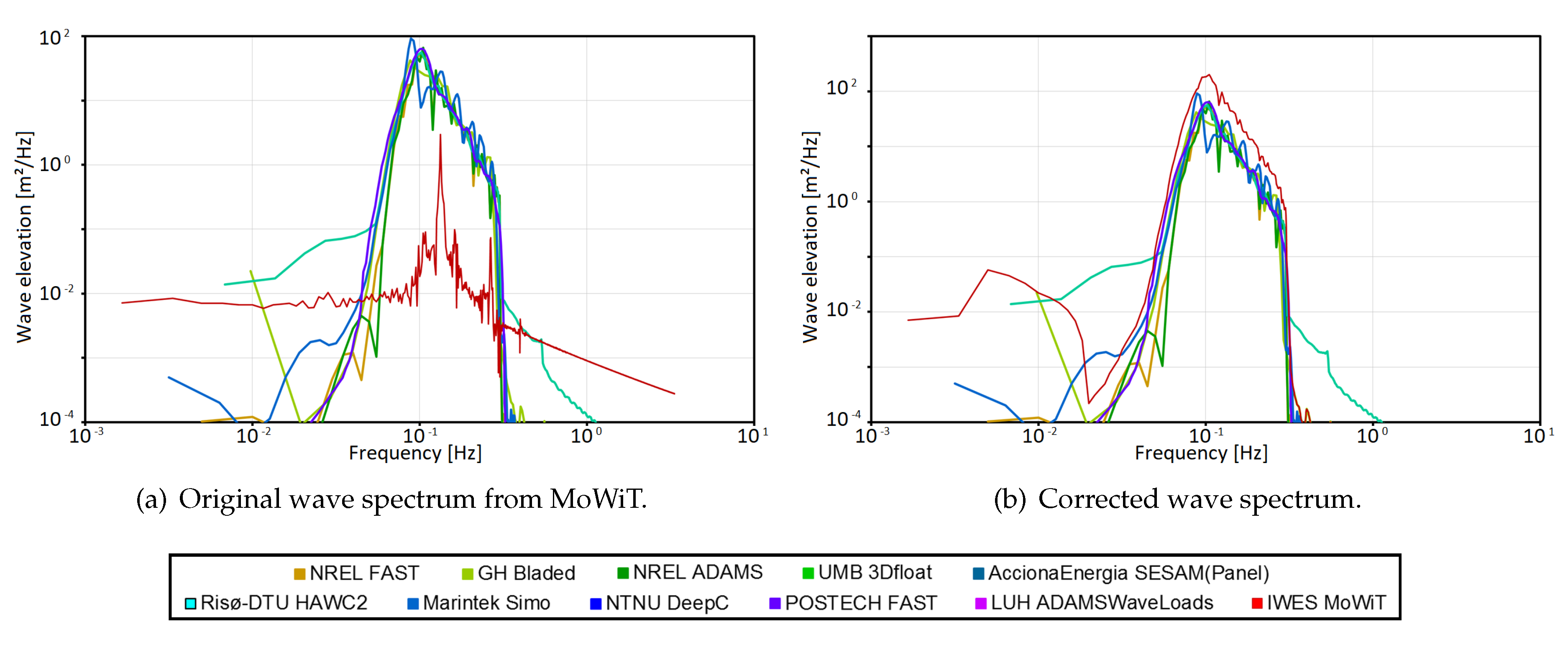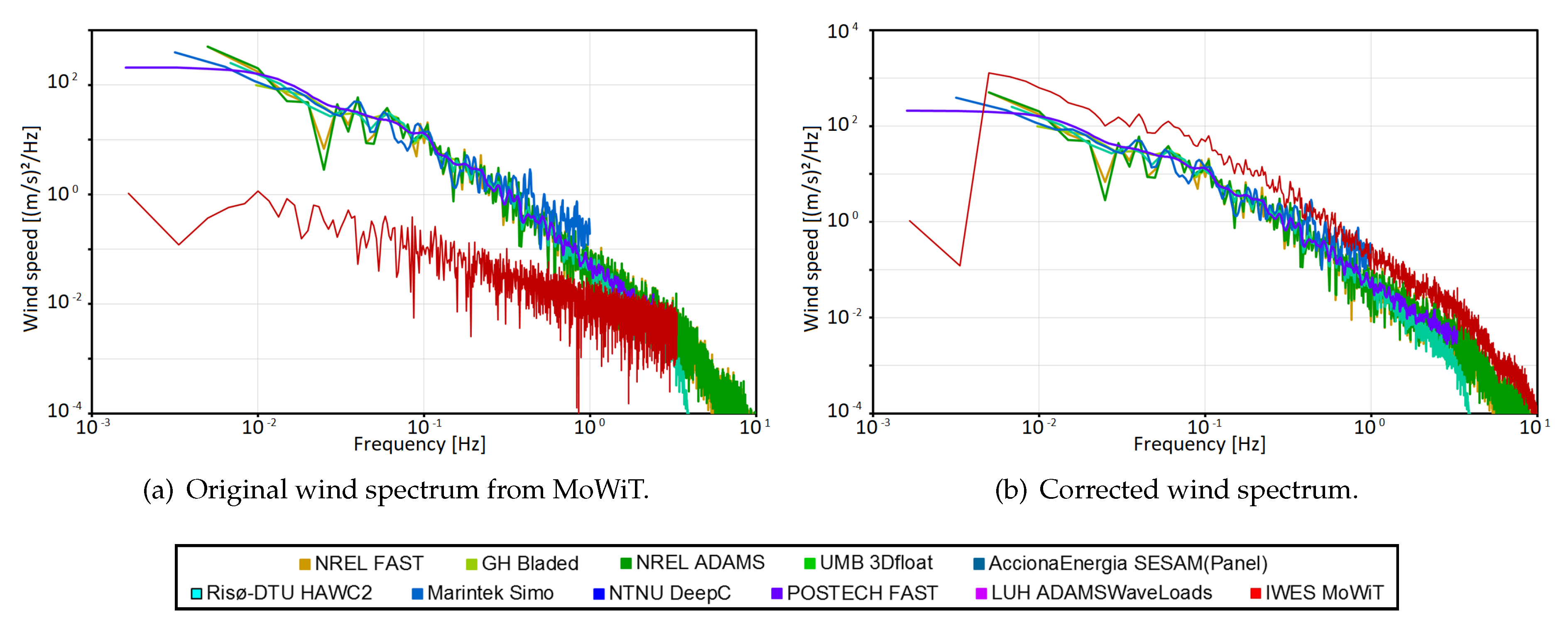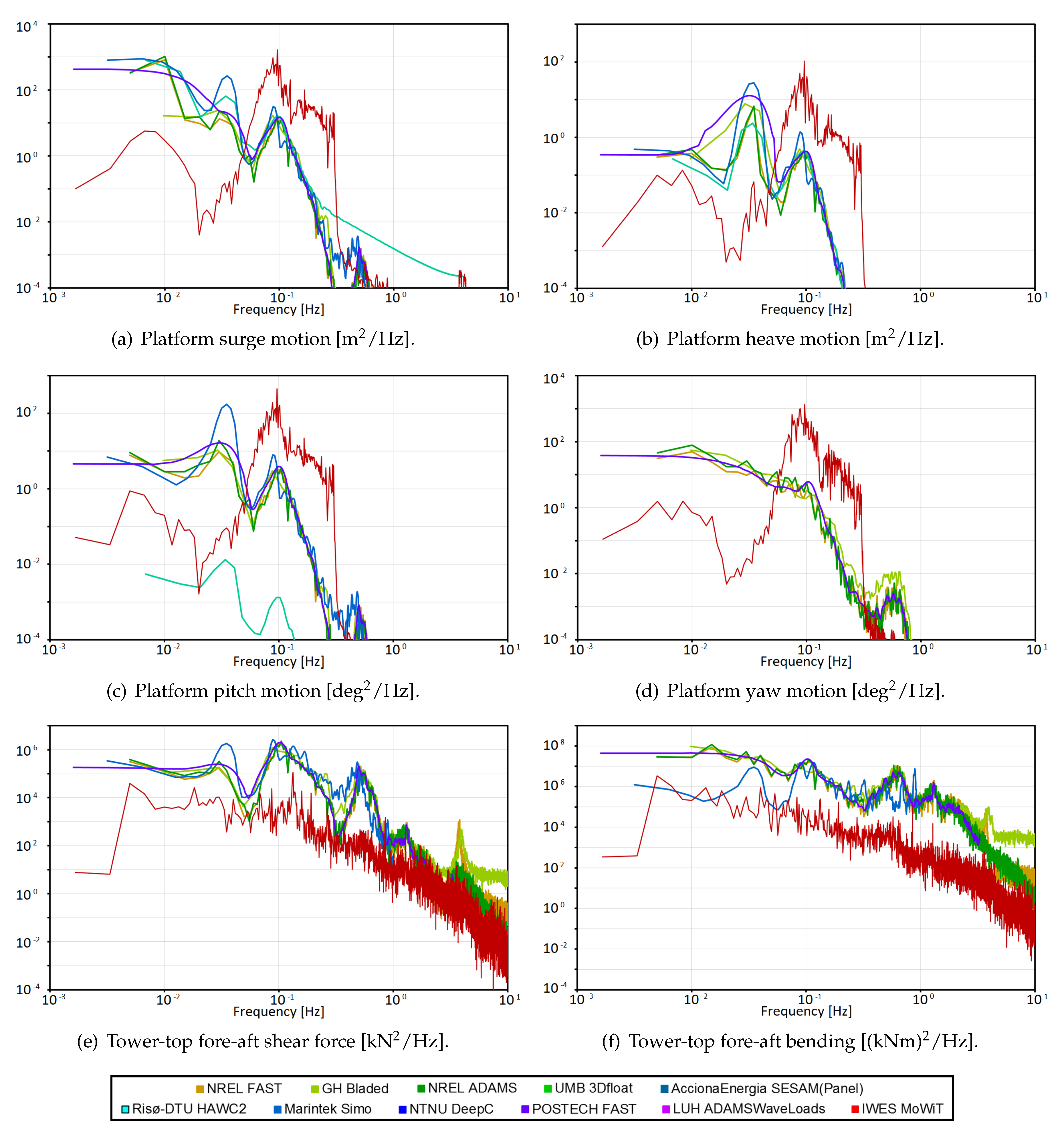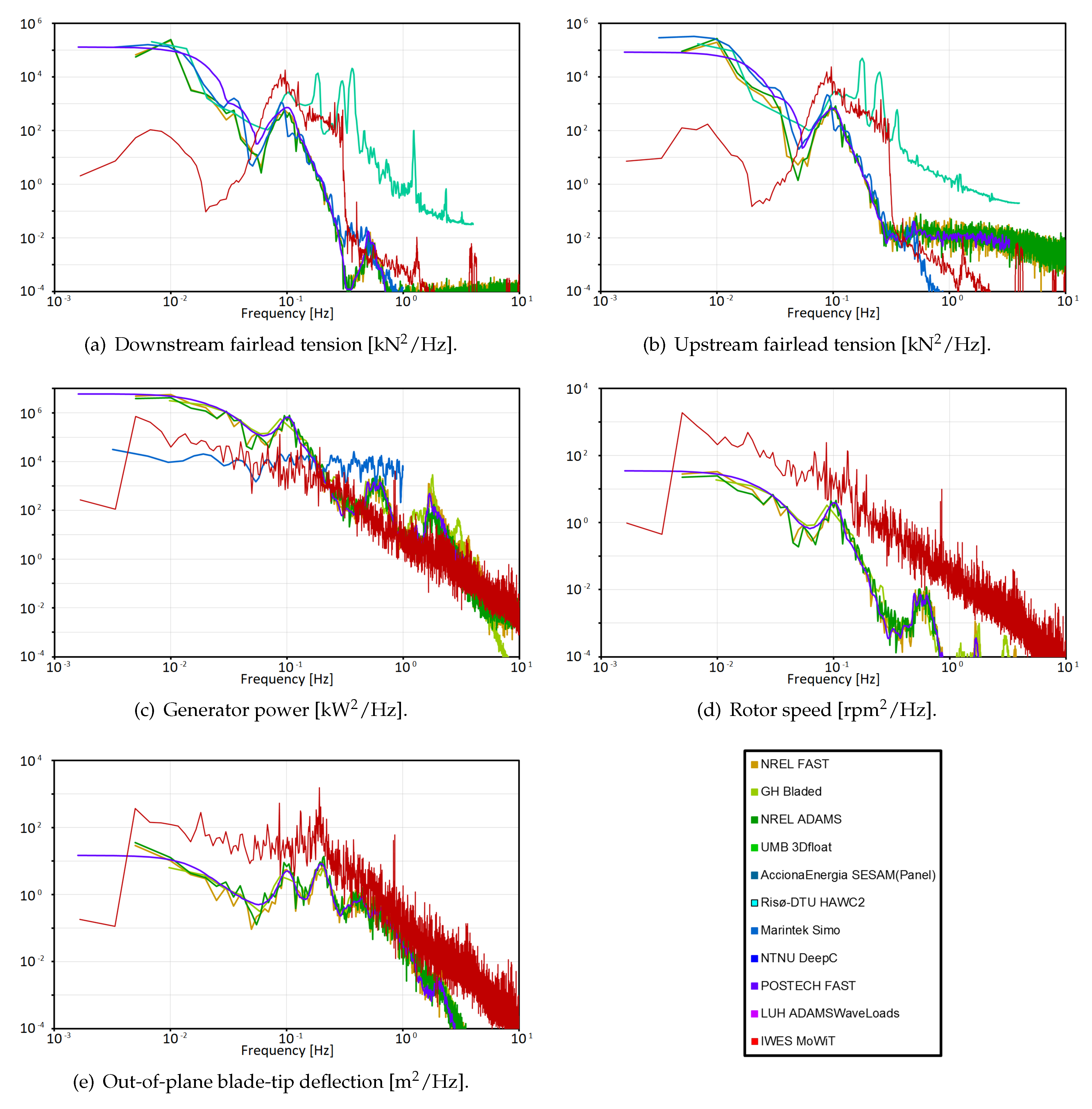1. Introduction and Outline
Offshore wind energy is becoming more and more interesting for the renewable energy industry. Depending on the location, water depth, and seabed conditions, different offshore wind turbine systems are required. Bottom-fixed solutions, such as monopiles, jackets, tripods, gravity-based structures, or suction buckets are limited to shallow and intermediate water depths. For deeper water sites, floating platforms, such as spar-buoys, semi-submersibles, or tension leg platforms, are required to support offshore wind turbines. Especially, spar-type floating support structures for offshore wind turbines are judged as being highly prospective for utilization in large commercial wind farms [
1,
2].
In comparison to onshore systems, offshore wind turbines have to deal with hydrodynamic loads in addition to wind loads. For floating offshore wind turbines (FOWTs) the system complexity increases even more. Apart from the environmental loads from wind, waves, and currents, the motion of the floating system leads to relative velocities, which have to be accounted for in the aerodynamic and hydrodynamic load calculations. Variable buoyancy loads are as well a consequence of the free motion of the system. Nevertheless, to keep the floater within a specific site, FOWTs have an additional component—the mooring system. This consists mostly of catenary mooring lines, or tendons in case of a tension leg floating platform, and anchors to fix the lines to the seabed. Thus, a FOWT system implies motion couplings, several different loading components, as well as non-linearities [
3,
4,
5,
6].
For this reason, modeling and simulation techniques are crucial for the assessment of FOWT system designs. However, it has to be ensured that the physical equations are correctly implemented in the code and the system behavior is realistically represented by the model. This is to be proved through verification and validation. Before validating the FOWT model, which in addition requires real measurements or test data, the code needs to be verified. Within the IEA (International Energy Agency) Wind Task 23 Subtask 2, the Offshore Code Comparison Collaboration (OC3) was developed to verify offshore wind turbine codes based on code-to-code comparison works [
7].
The participants of OC3 phase IV, which is on verifying a model of a floating spar-buoy offshore wind turbine system (described in detail in
Section 2.1) [
8], used various aero-hydro-servo-elastic modeling approaches as presented in
Figure 1. Very common and widely used tools are among others Bladed, HAWC2, and FAST. The wind turbine design software Bladed is a commercial software by DNV GL (Det Norske Veritas and Germanischer Lloyd), which is highly established and continuously enhanced in each newer version, is applied for system simulations, design, and certification, and has further advanced modules for specific applications such as advanced hydrodynamic calculations [
9,
10]. Another commercial aero-elastic code for wind turbine system simulation and response calculation is HAWC2 (Horizontal Axis Wind turbine simulation Code 2nd generation) developed at DTU (Technical University of Denmark) Risø Campus, which no longer only is used for aero-elastic simulations but also can represent floating systems [
11]. As well commercial, but right now also transferred to open-source development, is FAST (Fatigue, Aerodynamics, Structures, and Turbulence)—a simulation tool developed and used at NREL (National Renewable Energy Laboratory) for coupled analyses of horizontal-axis wind turbines, which can be combined with several other programs and packages for further advanced and detailed analyses, such as structural finite element analysis [
12]. Further software and modeling tools are for example ADAMS (Automatic Dynamic Analysis of Mechanical Systems) by MSC Software for simulating multibody dynamics of mechanical systems, which can as well be applied to FLOWTs [
13]; SIMO (Simulation of Marine Operations) by the Norwegian Marine Technology Research Institute (MARINTEK) for floating systems (originally mainly vessels) simulation, which can be advanced by means of the code RIFLEX for non-linear mooring line dynamics, coupled with HAWC2, and also be used for wind turbine systems by incorporating an external aerodynamic module [
14]; 3Dfloat developed at the Institute for Energy Technology at the (then called) University of Life Sciences (IFE-UMB) for fully-coupled simulation and advanced analyses of offshore structures, such as FOWTs [
15]; or SESAM software with the DeepC module by DNV GL for simulation and (un-)coupled analyses of floating structures and station-keeping systems, which however require a separate approach for integrating aerodynamics for a full offshore wind turbine system [
5]. More detailed reviews of the utilized modeling tools are provided in Reference [
16,
17] and the physics and theories implemented in the tools—all abbreviations mentioned under aerodynamics, hydrodynamics, control system, and structural dynamics in
Figure 1—are described in more detail in
Section 3.1 and
Section 4.2.
The results from these offshore code-to-code comparisons are used to verify a model of the above mentioned and in
Section 2.1 particularized floating spar-buoy wind turbine system from phase IV of OC3 [
8], which is implemented in MoWiT (Modelica for Wind Turbines) (formerly OneWind) , a library developed at Fraunhofer IWES (Institute for Wind Energy Systems), based on the object-oriented and equation-based modeling language Modelica (
https://www.modelica.org/ accessed: 15 January 2019). One advantage of using Modelica for modeling wind turbine systems is the hierarchical programing, by which means the complex system can be subdivided into single components. Thus, this component-based MoWiT library allows for modifications and replacements of individual component models, so that modeling and simulation of different system designs and boundary conditions can be realized. Furthermore, due to the possibility to couple MoWiT models to Python scripts, many more doors are being open for automated simulations, such as for design load case calculations, post-processing and analyses of simulation results, as well as other extensive tasks and applications, such as system optimization [
18,
19,
20,
21]. However, all these benefits would be as good as useless if the model and code is not yet verified.
Thus, the aim of this paper is to develop a fully-coupled FOWT system model based on the MoWiT library. This implemented model of dynamics shall be capable of aero-hydro-servo-elastic time-domain simulations and be highly flexible with respect to the considered ((floating) offshore) wind turbine system and environmental conditions. By means of code-to-code comparisons, utilizing the OC3 phase IV floating spar-buoy system and corresponding results from previous research work, the developed fully-coupled FOWT system model shall be verified.
In this paper, first, the considered spar-buoy floating offshore wind turbine system from phase IV of OC3 is introduced in
Section 2. Based on the system definition, the FOWT is implemented in Modelica using the MoWiT library (
Section 3). Afterwards, the main task of verifying this model is performed based on code-to-code comparison works and results are presented in
Section 4. More detailed discussion and analyses of the results follow in
Section 5. Finally, some conclusions, including a short summary and outlook, are given in
Section 6.
3. Modeling of the OC3 FOWT in MoWiT
Modeling of a FOWT system can be done by means of various software architectures, which are based on different simulation codes with varying capabilities for aero-hydro-servo-elastic calculations, as pointed out in References [
16,
17]. Within the OC3 project, the floating spar-buoy wind turbine system from phase IV, as described in
Section 2, was modeled by the project participants in different codes and tools for wind turbine system simulation, as introduced in
Section 1, to be compared and verified within the study [
7]. For the same purpose of code verification and to add one more result to the cross-code comparison, the OC3 FOWT is implemented in the modeling language Modelica, using the MoWiT library for fully-coupled aero-hydro-servo-elastic dynamic simulation of wind turbine systems, developed at Fraunhofer IWES [
25,
26,
27]. In the following, first (
Section 3.1), this library and the modeling environment is introduced briefly to point out the advantages and capabilities of this tool. Afterwards (
Section 3.2), the methodology of implementing the OC3 FOWT system is outlined, demonstrating as well difficulties which arose and assumptions that had to be made.
3.1. The MoWiT Library
The MoWiT library, which is developed at Fraunhofer IWES and is available free of charge for academic use, allows modeling of state-of-the-art onshore or offshore wind turbine systems to be simulated in Dymola (
http://www.dymola.com/ accessed: 15 January 2019), the Dynamic modeling laboratory by Dessault Systèmes [
28,
29], for load calculations and further analyses. The component-based library is based on the object-oriented and equation-based open-source modeling language Modelica. The hierarchical structure of programing in Modelica, as well as the multibody approach adopted in Modelica, benefit the modeling of such a complex system as a wind turbine. Hence, the wind turbine system is broken down into single components (main and subcomponents), as shown in
Figure 4, which are modeled separately and interconnected to represent correctly couplings and interactions between them. This structure also allows fast and easy exchange of single components to model different wind turbine technologies, turbine or support structure designs, control strategies, or site and environmental conditions. Furthermore, as MoWiT is under development by Fraunhofer IWES, code modifications, optimizations, and enhancements are always possible [
19,
25,
26,
27].
As presented in
Figure 4, a FOWT, such as the OC3 spar-buoy system shown as well in
Figure 5, consists of six main components, of which two are for the environmental parameters. Within these main components there are several subcomponents and options to be modeled. Hence, apart from the hub, a specified number of blades (for common wind turbines mostly three or two), represented as either rigid or flexible structures, make up the wind turbine rotor. This is, among others, connected to the nacelle with the structural models of drivetrain (rigid or flexible in one torsional degree of freedom) and generator (fixed or variable speed). The nacelle as well contains the yaw controller; however, the remaining control systems for pitch and torque control, following PI-algorithms or an external dynamic link library (DLL) for running various operating phases, are incorporated in the operating control. The whole representation of the floating structure—including the tower, potential ballast, and the station-keeping system—is done in the support structure model, comprising as well the determination of all (aerodynamic, hydrostatic, and hydrodynamic) loads and motions. With respect to the aerodynamics, MoWiT can base the calculations on the blade-element momentum (BEM) theory [
30,
31,
32,
33] or the generalized dynamic wake (GDW) model [
34,
35] and incorporate corrections for dynamic wake and dynamic stall (DS); regarding the hydrodynamics, the library is capable of linear Airy [
36] or non-linear Stokes wave theory [
24,
37], Wheeler stretching (WS) or delta stretching [
38], Morison equation (ME) [
39], and MacCamy-Fuchs (MCF) approach [
40]. For the structural dynamics, the finite-element method (FEM), based on Euler-Bernoulli or Timoshenko beam theory, or modal reduction can be used for the floater and turbine representation, while the mooring lines are modeled through a mass-spring-damping (MSD) system, which considers, apart from the dynamic inertial motion of the mooring system, hydrodynamic and internal damping, elastic deformation, as well as soil contact, and uses the catenary equation for determining the initial shape and position of the mooring line elements. Finally, the two environmental models for wind and waves, including also currents, allow the realization of various steady or turbulent, regular or irregular, aligned or misaligned, and normal or extreme environmental conditions and sea states [
25,
26,
27].
An overview of the structure of the MoWiT model is presented in
Figure 6. It shows the required inputs for the wind turbine system and the environment and points out the approaches for the fully-coupled aero-hydro-servo-elastic dynamic calculations, based on which the final system responses are determined and obtained as outputs.
The simulations of models developed in the MoWiT library are performed in the time-domain and executed in Dymola. This simulation engine is highly suited for modeling complex systems, such as FOWTs, which come with a large number of system equations. Dymola provides various solvers with fixed or variable step size and following implicit or explicit method, to cope with a broad range of problems and system equation types.
3.2. Implementation of the OC3 FOWT in MoWiT
The OC3 FOWT system is modeled in MoWiT according to the definitions given in References [
8,
22] and presented in
Section 2. However, not all data relevant for modeling the system correctly are specified explicitly in these documents. Hence, in the following, the used, either prescribed or derived, parameters of the system components are addressed.
For the wind turbine, both the rotor and nacelle, as well as the operating control system, extensive data are available in Reference [
22] and in Reference [
8] for the adaptions made specifically for the OC3 spar-buoy floating wind turbine system. Thus, the entire RNA (modeled as flexible structure with modal reduced blades) and operating control can be implemented correctly in MoWiT according to the definitions. The comparison of the total RNA mass, presented in
Table 4, shows perfect agreement.
The support structure model comprises tower and floater, as already mentioned in
Section 3.1. Within the code-to-code comparisons of OC3 phase IV, the spar-buoy is considered as rigid structure throughout all load cases [
7], which are introduced in
Section 4.1. Only the tower was sometimes represented as rigid or flexible structure in the OC3 code-to-code comparisons. As the focus of the verification is on the floating platform, a rigid support structure model is utilized in MoWiT.
The structural part of the support structure, concerning the wind turbine tower, is described in depth in Reference [
8], on which basis the tower with its distributed properties can be implemented from the top of the floating platform up to the RNA position through individual rigid cylindrical segments. The overall tower mass and corresponding center of mass are presented in
Table 4 and compared to the specified values. There is just a minor deviation in the tower mass, which might be due to the fact that the tower is conical, however, each element is modeled as straight cylinder based on its averaged top and bottom diameter.
For the floating platform, however, only the main parameters for geometry, outer dimensions, as well as total mass and inertia properties are provided in Reference [
8]. Other parameters, relevant for modeling the structure and its characteristics properly, such as cap and (distributed) wall thickness values, material properties, or any information regarding the ballast system, are missing, as already indicated in
Section 2.1. To overcome this issue, the unavailable parameters are determined—in the following way and based on the assumptions described hereinafter—to match the existing data resulting for the total system, accordingly the resulting mass-related properties (
Table 2), as good as possible.
The floating platform, being part of the support structure model, is implemented as the tower through rigid cylindrical segments. As no distributed properties are available for the spar-buoy, four cylindrical bodies are used based on the geometry of the floater: (1) one for the bottom cylinder with given length and diameter; (2) one for the tapered part, as connection between the bottom and top cylinder, with determined length and averaged diameter of bottom and top cylinder; (3) one for the top cylinder with given length and diameter; and (4) one for modeling the ballast within the bottom cylinder.
As no structural analysis is going to be carried out within the OC3 code-to-code comparisons, the cap thickness—meaning the thickness of the bottom cap of the bottom cylinder, as well as the thickness of the cap on the upper end of the top cylinder—is set equal to 1.0 × 10−4 m to avoid large contribution of the caps to the total mass due to any too large assumed value.
Each of the three structural cylinders (1)–(3), described in the first bullet point, is defined through its outer diameter and length, which are both provided or—in case of the tapered (2) part—determined as described beforehand, its wall thickness, as well as its material density. The latter two are assumed to be the same for the three cylindrical parts of the floating structure. As the platform inertia values are relevant for the dynamic response of the floating system, it is tried to match these inertia values as good as possible by modifying assumed values for the material density and wall thickness of the spar. First, it is presumed that the specified parameters for the inertia values are for the platform including ballast, because no separate values are given for the ballast and the total inertia is important for the dynamics. Furthermore, as it is not possible to match all (roll, pitch, and yaw) inertias at the same time under the assumptions made, it is focused on achieving correct values at least for the roll and pitch inertias, because these are usually more important than the yaw inertia.
The calculations are based on the target value search in Excel. The starting value for the material density is 7850 kg/m
, assuming typical steel properties, and an upper bound is set at 10,000 kg/m
. For the wall thickness, taking on one constant value for the entire platform for reasons of simplicity and as already mentioned above, the starting value is 0.1 m, which is at the same time the upper bound. With these settings, the target value search results in a material density of 10,000 kg/m
and a wall thickness of 0.0314 m. With these parameters, the difference in the platform roll and pitch inertias is with 1.58 × 10
−7% negligible, while the achieved yaw inertia is 43.57% smaller than the defined value, as presented in
Table 2.
As the upper bound for the material density is reached, the target value search is again executed with removed upper limit. The result, however, is that an unfeasible high material density is reached, while the wall thickness would be unrealistically thin and the discrepancy between better matching the platform roll and pitch inertias, however, higher deviation in the yaw inertia becomes greater. Thus, the results obtained when limiting the material density to common and feasible values are kept.
A better match of the yaw inertia value could have been achieved by segmentation of the cylindrical structural elements of the spar-buoy. However, with unknown number of segments and length distributions, a full match of all inertia values at the same time is questionable to be obtained. Thus, as the focus in this paper is the verification of the modeling approach and implemented theories and coupled dynamics, a compromise is needed between available data and perfect match of resulting system properties. As mentioned above, the main focus is on the most important inertia components, namely for roll and pitch, and, hence, the discrepancy in the system yaw inertia is accepted and accounted for when analyzing the results of the code-to-code comparison, as covered in
Section 5.
Having the material density and wall thickness set, the ballast density and ballast height are determined to match the total platform mass including ballast of 7466.3 t, as specified in
Table 2. Due to the small difference in the tower mass, outlined before and in
Table 4, the second criterion for determining the ballast parameters would either be
the same center of mass of platform including ballast at 89.9155 m below SWL;
or the same resulting center of mass of tower and platform including ballast at 85.6009 m below SWL;
or the same total restoring moment due to tower, platform, and ballast.
Due to the minor discrepancy in the tower mass, all three options for the second criterion yield very similar ballast parameters. Nevertheless, the second option to meet the same total center of mass is selected to avoid altering the response in pitch and roll by a shifted center of gravity. This results in a ballast density of 1907 kg/m
and a ballast height of 48.3708 m, which yields a perfect match in the total platform mass and a minor deviation in the position of the center of mass of the floater, as presented in
Table 2.
Table 5 summarizes the settings of the unavailable floater parameters, used for the modeling in MoWiT. With these settings, a resulting hydrostatic buoyancy force, determined based on the geometry and presuming a gravitational acceleration of 9.81 m/s
, of 80,724,636 N is obtained. This deviates by 2.0 × 10
−2% from the specified value, mentioned in
Section 2.1, what is mainly expected to come from a slightly different gravitational acceleration value taken in the OC3 phase IV definition. The hydrostatic restoring is, as opposed to the OC3 system definition in Reference [
8], not explicitly defined within the MoWiT model but a result of the implemented system properties. Hence, a quantitative comparison of the hydrostatic restoring values is not possible. However, the precise representation of the floater geometry and its center of mass allow to draw conclusions on the correct representation of the hydrostatic restoring. This as well can be examined indirectly when analyzing the simulation results. In contrast to the hydrostatic restoring values, the additional damping parameters, outlined in
Section 2.1 and stated in Reference [
8], are implemented separately in MoWiT and the hydrodynamic coefficients are set according to the definitions.
The mooring system properties, including as well the additional yaw spring stiffness specified in Reference [
8] and mentioned in
Section 2.1 are implemented in the MoWiT model according to the definitions.
Finally, the OC3 spar-buoy FOWT model, implemented as described above in the MoWiT library, is simulated in Dymola. The specific simulation and solver settings are stated in
Section 4.1 for each simulation case separately. A visualization of the modeled system is shown in
Figure 5.
6. Conclusions
In this paper, the MoWiT library is used for fully-coupled aero-hydro-servo-elastic simulations of the spar-buoy FOWT system from OC3 phase IV. The benefit of using the object-oriented and equation-based modeling language Modelica with its hierarchical programing structure and the utilized multibody approach is the component-based modeling, which allows for implementation of such a complex system by breaking it down into its components and enables modifications and replacements of the single component models. During implementation of the OC3 spar-buoy FOWT system, it appeared that not all required data is available. Hence, some parameter values, such as wall thickness(es), material densities, or ballast height, needed to be derived based on the given information, but also implying some assumptions to be made. Not for all resulting variables—mainly the platform yaw inertia—a perfect match can be obtained, which leads to some anticipated deviations from the MoWiT results to the results from the OC3 phase IV participants. The model is simulated for different load conditions and a comprehensive analysis of the simulation results in comparison to the OC3 phase IV results from other codes is performed. The initial deviation in the yaw inertia is reflected in a significantly higher natural frequency in yaw, which is encountered in all corresponding time series. Taking account of start-up transients in the time series, the results for the hydro-elastic, as well as aero-hydro-servo-elastic simulations with regular waves, as well as steady wind in the latter case, are highly comparable with the results from the other modeling tools. However, for irregular waves and turbulent wind, discrepancies are observed due to deviations in the input spectra. In order to still verify the results, the differences in the input are eliminated in post-processing, yielding a better match of the results; however, for further studies and applications of the MoWiT library it is envisaged to improve and verify the environmental spectra generated by means of the library. Apart from the expected differences, the code-to-code comparisons of the simulation results with the MoWiT model show overall good agreement with the results from various other wind turbine system tools used by the OC3 phase IV participants. Thus, the MoWiT library can be utilized in equal measure for fully-coupled aero-hydro-servo-elastic simulations of FOWT systems. For a final validation of the utilized codes, real data would be required.
